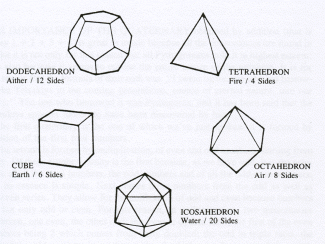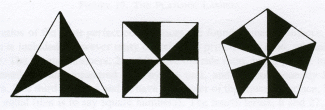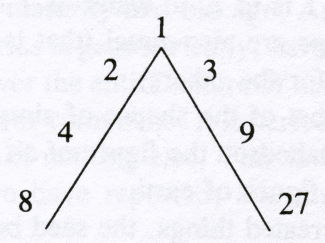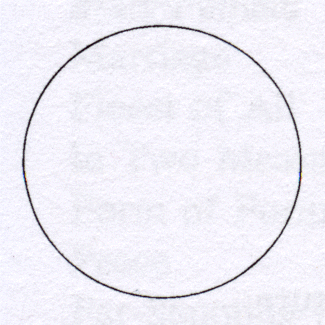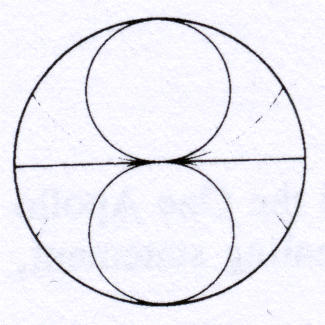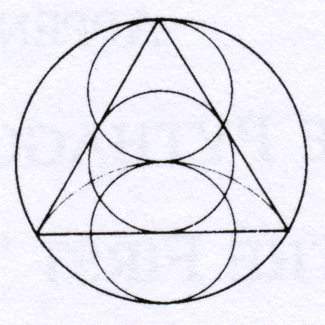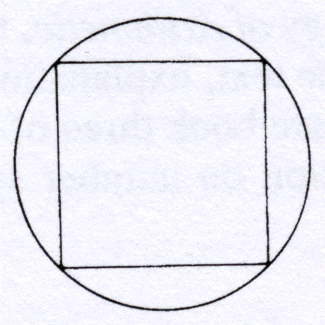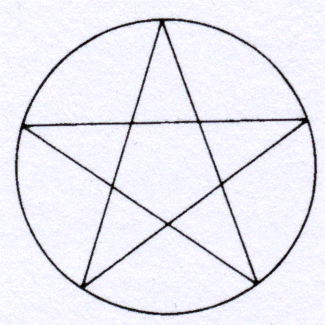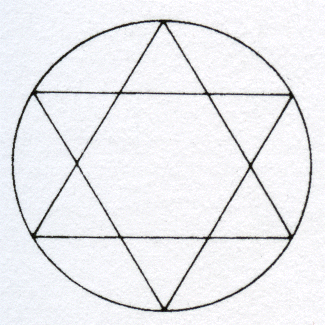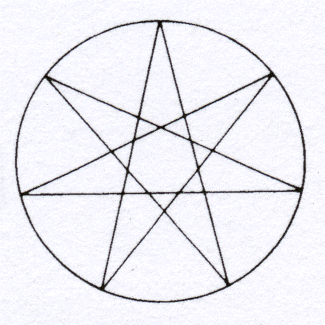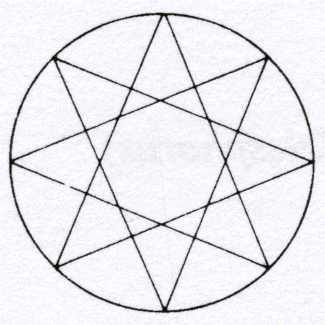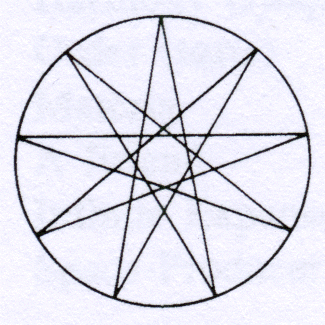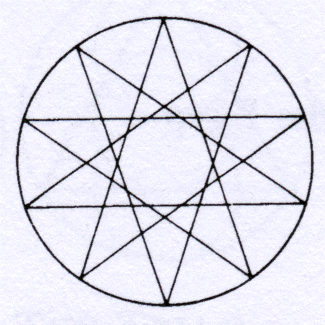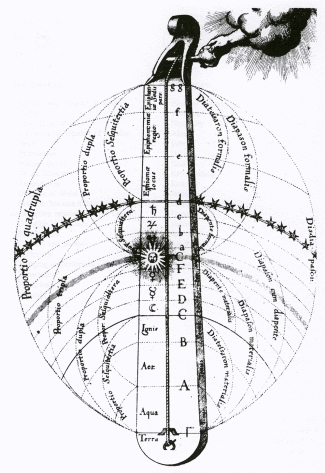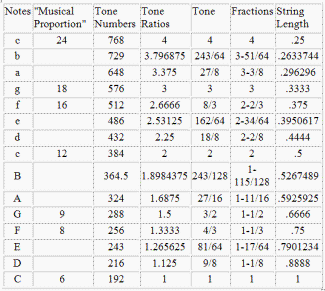ON THE WORLD AND THE SOUL
TIMAEUS OF LOCRI is the central character of Plato's dialogue dealing with Pythagorean cosmology but it is uncertain whether or not there ever actually was a Timaeus of Locri who was a Pythagorean.
This particular writing may have gone through several stages of composition. It started out as an epitome of the cosmology of the Platonic dialogue. However, certain important details are not adequately treated and, in general, the cosmology is reduced to a series of statements while the underlying explanations and reasonings are omitted. At this stage the writing could well have been a summary of a student, and it seems likely that the attribution of the writing to Timaeus was added at a later date. Also added at a later date was a table of tone numbers which relate to the division of the world soul.
The best translation of this work is that of Thomas Tobin, published by Scholars Press in 1985, which features a good introduction and extensive notes. Tobin argues persuasively that this work may be seen as a Middle Platonic interpretation of the Timaeus; hence it was probably composed in the first century of, or before, the common era.
While Plato's Timaeus constitutes essential reading for anyone interested in Pythagorean cosmology, the writing reproduced here possesses more significance for the history of Middle Platonism than it does for the study of Pythagorean thought.
ON THE WORLD AND THE SOUL
1. Mind, Necessity, Form and Matter
TIMAEUS OF LOCRI said the following:
Of all the things in the universe there are two causes: Mind, of things existing according to reason; and Necessity, of things [existing] by force, according to the power of bodies. The former of these causes is the nature of the good, and is called God, and the principle of things that are best, but what accessory causes follow are referred to Necessity. Regarding the things in the universe, there exist Form, Matter and the Perceptible which is, as it were, an offspring of the two others. Form is unproduced, unmoved, stationary, of the nature of the Same, perceptible by the mind, and a pattern of such things produced as exist by a state of change: that is what Form is said to be.
Matter, however. is a recipient of impressions, is a mother and a nurse, and is procreative of the third kind of being; for receiving upon itself the resemblances of form, and as it were remoulding them, it perfects these productions. He asserted moreover that matter, though eternal, is not unmoved; and though of itself it is formless and shapeless, yet it receives every kind of form; and that which is around bodies is divisible and partakes of the nature of the Different; and that matter is called by the twin names of Place and Space.
These two principles then are opposite to each other, of which Form is analogous to a male power and a father, while matter is analogous to a female power and a mother. The third thing is their offspring. Being three, they are recognizable by three marks: Form, by mind, according to knowledge; Matter by a spurious kind of reasoning, because it cannot be mentally perceived directly, but by analogy; and their production by sensation and opinion.
2. Creation of the World
BEFORE THE HEAVENS, then, there existed through reason Form and Matter, and the God who develops the best. But since the older surpasses the younger, and the ordered surpasses the orderless, the deity, being good -- on seeing that Matter receives Form, and is altered in every way, but without order -- found the necessity of organizing it, altering the undefined to the defined, so that the differences between bodies might be proportionately related, not receiving various alterations at random. He therefore made this world out of the whole of Matter, laying it down as a limit to the nature of being, through its containing in itself the rest of things, being one, only-begotten, perfect, endowed with soul and reason -- for these qualities are superior to the soulless and the irrational -- and of a sphere-like body, for this is more perfect than the rest of forms.
Desirous then of making a very good production he made it a divinity, created and never to be destroyed by any cause other than the God who had put it in order, if indeed he should ever wish to dissolve it. But on the part of the good there is no rushing forward to the destruction of a very beautiful production. Such therefore being the world, it continues without corruption and destruction, being blessed. It is the best of things created, since it has been produced by the best cause, which looked not to patterns made by hand but to Form in the abstract, and to Existence, perceiving by the mind to which the created thing, having been carefully adjusted, has become the most beautiful. It is even perfect in the realm of sense because its pattern, containing in itself all the living things perceived by mind, left out nothing, being the limit of the things perceived by mind, as this world is of those perceived by sense.
Being solid and perceptible by touch and sight, the world has a share of earth and fire, and of the things between them, air and water; and it is composed of all perfect bodies, which are in it as wholes, so that no part might ever be left out, in order that the body of the Universe might be altogether self-sufficient, uninjured by corruption from without or within; for apart from these there is nothing else, and hence the things combined according to the best proportions and with equal powers, neither rule over, nor are ruled by each other in turn, so that some receive an increase, others a decrease, remaining indissolubly united according to the very best proportions.
3. Proportions of the World Combination
WHENEVER THERE ARE any three terms with mutually equal intervals that are proportionate, we then perceive that, after the matter of an extended string, the middle is to the first, as is the third to it, and this holds true inversely and alternately, interchanging places and order, so that it is impossible to arrange them numerically without producing an equivalence of results. Likewise the world's shape and movement are well arranged; the shape is a sphere, self-similar on all sides, able to contain all shapes that are similar, and the movement endlessly exhibits the change dependent on a circle. Now as the sphere is on every side equidistant from the center, it is able to retain its poise whether in movement or at rest, neither losing its poise nor assuming another. Its external appearance being exactly smooth, it needs no mortal organs such as are fitted to and present in all other living beings because of their wants. The world soul's element of divinity radiates out from the center entirely penetrating the whole world, forming a single mixture of divided substance with undivided form; and this mixture of two forces, the Same and the Different, became the origin of motion, which indeed was not accomplished in the easiest way, being extremely difficult.
Now all these proportions are combined harmonically according to numbers, which proportions were scientifically divided according to a scale which reveals the elements and the means of the soul's combination. Now seeing that the earlier is more powerful in power and time than the later, the deity did not rank the soul after the substance of the body, but made it older by taking the first of unities, 384. Knowing this first, we can easily reckon the double (square) and the triple (cube); and all the terms together, with the complements and eights, there must be 36 divisions, and the total amounts to 114,695.
These are the divisions
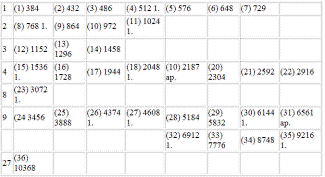
FIGURE 15. A TABLE OF TONE NUMBERS. There is evidence that this table of tone numbers is a later addition to the text. The abbreviations I. and ap. represent the two types of semitones, the leimma and the apotome respectively.
4. Planetary Revolutions and Time
GOD THE ETERNAL, the chief ruler of the Universe and its creator, is beheld alone by the mind, but we may behold by sight all that is produced in this world in connection with those parts which are heavenly, and, being ethereal, must be divided into kinds: some relating to Sameness, others to Difference. Sameness draws onward all that is within, with the general motion of the entire sphere of the universe from east to west. Difference draws along all self-moved portions from west to east, fortuitously rolled around and along by the superior power of Sameness. [1]
The movement of the Different, being divided in harmonic proportion, assumes the order of seven circles. Nearest to the earth the Moon revolves in a month, while beyond her the Sun completes his revolution in a year. Two planets run co-equal with that of the sun: Mercury and the star of Hera, the latter of which is also called the star of Venus and the Lightbringer because shepherds and common people, generally not skillful in sacred astronomy, confuse the western and eastern risings. The same star may shine in the west when following the sun at a distance great enough to be viewed in spite of solar splendor; and at another time in the east when, as herald of the day, it rises before the sun, leading it. Because of its running together with the sun, Venus is the Lightbringer frequently but not always; for there are planets and stars of any magnitude seen above the horizon before sunrise, herald of the day. But the three other planets, Mars, Jupiter and Saturn have their peculiar velocities and different years, completing their course while making their periods of effulgence, of visibility, of obscuration and eclipse, accurately rising and setting. Moreover, they complete their appearances conspicuously in the east or west according to their position relative to the sun who, during the day, speeds westward, which during the night it reverses, under the influence of Sameness, while its annual revolution is due to its inherent motion. In consequence of these two kinds of motion it roils out a spiral, moving one degree each day, but is whirled around under the sphere of the fixed stars according to each revolution of darkness and day.
Now these revolutions are by men called portions of time, which the deity arranged together with the world. For before the world the stars did not exist, and hence there was neither year, nor periods of season, by which this generated time is measured, and which is the representation of the ungenerated time called eternity. For as this heaven has been produced according to an eternal pattern, the world of ideas, so was our world-time created simultaneously according to the pattern of eternity.
5. The World's Creation by Geometric Figures
THE EARTH, fixed at the center, becomes the hearth of the Gods and the boundary of darkness and day, producing settings and risings according to the occultation produced by the things that form the boundary, just as we improve our sight by making a tube with our closed hand, to exclude refraction. Earth is the oldest body in the heavens. Water was not produced without earth, nor air without moisture, nor could fire continue without moisture and the materials that are inflammable, so that earth is fixed upon its balance at the root and base of all other substances.
Of produced things, the substratum is Matter, while the reason of each shape is abstract Form; of these two the offspring is Earth and Water, Air and Fire.
This is how they were created. Every body is composed of surfaces, whose elements are triangles, of which one is right-angled, and the other has all unequal sides, with the square of the longer side being thrice the size of the lesser, while its least angle is the third of a right angle. The middle one is the double of the least, for it is two-thirds of a right angle. The greatest is a right angle, being one-and-a-half times greater than the middle one, and the triple of the least. Now this unequal sided triangle is half of an equilateral triangle, cut into two equal parts by a line let down from the apex to the base. In each of these triangles there is a right angle; but in the one, the two sides about the right angle are equal, and in the other all the sides are unequal. Now let this be called a scalene triangle; while the other, the half of the square, is the principle of the constitution of Earth. For the square produced from this scalene triangle is composed of four half-squares and from such a square is produced the cube, the most stationary and steady form in every way, having six sides and eight angles. On this account Earth is the heaviest and most difficult elemental body to move, and its substance is inconvertible, because it has no affinity with the other type of triangle. Only Earth has a peculiar element of the square, while the other triangle is the element of the three other substances, Fire, Air and Water. For when the half triangle is put together six times it produces the solid equilateral triangle, the exemplar of the tetrahedron, which has four faces with equal angles, which is the form of Fire, as the easiest to be moved, and composed of the finest particles. After this ranks the octahedron, with eight faces and six angles, being the element of Air; and the third is the icosahedron, with twenty faces and twelve angles, being the element of Water, composed of the most numerous and heaviest particles.
These then, as being composed of the same element, are transmuted into one another. But the deity made the dodecahedron the image of the Universe, as being the nearest to the sphere. Fire then, by the fineness of its particles, passes through all things; and Air through the rest of things, with the exception of Fire; and Water through the Earth. All things are therefore full, and have no vacuum. They cohere by the revolving movement of the Universe, and are pressed against and rubbed by each other in turn, and produce the never- failing change from generation to destruction.
6. Concretion of the Elements
BY MAKING USE OF THESE THE DEITY put together this world, sensible to touch through the particles of Earth, and to sight through those of Fire, which two are the extremes. Through the particles of Air and Water he had conjoined the world by the strongest chain, namely proportion, which restrains not only itself but all its subjects. Now if the conjoined object is a plane surface one middle term is sufficient, but if a solid there will be need of two mean terms. With two middle terms, therefore, he combined two extremes, so that as Fire is to Air, Air is to Water; and as Air is to Water, so is Water to Earth; and by alternation, as Fire is to Water, Air might be to Earth. Now since all are equal in power, their ratios are in a state of equilibrium. This world then is one, through the bond of the deity, made according to proportion.
Now each of these substances possesses many forms. Fire has those of flame, burning and luminousness, through the inequality of the triangles in each of them. In the same manner Air is partly clear and dry, and partly turbid and foggy. Water can be partly flowing and partly congealed, as it is in snow, frost, hail or ice. That which is moist is in one respect flowing as honey and oil, but in another is compact as pitch and wax. Concerning solids some are fusible, as gold, silver, copper, tin, lead and copper, and some brittle as sulphur, asphalt, nitre, salt, alum, and similar materials.
7. Composition of the Soul
AFTER PUTTING TOGETHER THE WORLD, the deity planned the creation of mortal beings so that, himself being perfect, he might perfectly complete the world. Therefore he mixed up the soul of man out of the same proportions and powers, and after taking the particles and distributing them, he delivered them over to Nature, whose office is to effect change. She then took up the task of working out mortal and ephemeral living beings, whose souls were drawn in from different sources, some from the moon, others from the sun, and others from various planets, [from] that cycle within the Difference, with the exception of one single power which was derived from Sameness, which she mixed up in the rational portion of the soul, as the image of wisdom in those of a happy fate.
Now in the soul of man one portion is rational and intellectual, and another irrational and unintellectual. Of the logical part the best portion is derived from Sameness, while the worst comes from Difference, and each is situated around the head so that the other parts of the soul and body may minister to it, as the supreme part of the whole body. Of the irrational portion, that which represents passion hovers around the heart, while desire inhabits the liver. The principle of the body and root of the marrow is the brain, wherein resides the ruling power; and from this, like an effusion, through the back-bone flows what is left over from the brain, from which are separated the particles of semen and seed. The marrow's surrounding defenses are the bones, of which the flesh is the covering and concealment. To the nerves he united joints by tendons, suitable for their movement. Of the internal organs, some exist for the sake of nourishment and others for safety. Of exterior motions, some are conveyed to the interior intelligent places of perception while others, not falling under the power of apprehension, are unperceived, either because the affected bodies are too earth-like or because the movements are too feeble. The painful movements tend to arouse nature, while the pleasurable lull nature into remaining within herself.
8. Sensations
AMONG THE SENSES, the deity has in us lit sight to view the objects in the heavens and for the reception of knowledge, while to make us capable to receive speech and melody, he has implanted hearing in us, of which he who is deprived thereof from birth will become dumb, nor be able to utter any speech, and that is why this sense is said to be related closest to speech.
Many affections of the body that have a name are so called with reference to touch, and others from relation to their seat. Touch judges the properties connected with life such as warmth, coldness, dryness, moisture, smoothness, roughness, and of things that are yielding, opposing, hard or soft. Touch also judges heaviness or lightness. Reason defines these affections as being centripetal and centrifugal, which men mean to express when they say below and middle. For the center of a sphere is below, and that part lying above it and stretching to the circumference is called upwardness.
Now what is warm appears to consist of fine particles, causing bodies to separate, while coldness consists of the grossness of the particles, causing a tendency to condense.
The circumstances connected with the sense of taste are similar to those of touch. For substances grow either astringent or smooth through contraction and dilation, also by entering the pores and assuming shapes. For those that cause the tongue to melt away, or that scrape it, appear to be rough. Those that act moderately in scraping appear brackish. Those that inflame or separate the skin are acrid; while their opposites, the smooth and sweet, are reduced to a juicy state.
The kinds of odors have not been defined because they percolate through narrow pores that are too stiff to be closed or separated. Things seem to be sweet smelling or bad smelling from the putrefaction or concoction of the earth and of similar substances.
A vocal sound is a percussion in the air, arriving at the soul through the ears. The passages of the ears reach to the liver, and among them is pneuma, by the movement of which hearing exists. Now of the voice and hearing, that portion which is quick is acute, while that which is slow is grave, the medium being the most harmonious. What is much and diffused is great; what is little and compressed is small; what is arranged to musical proportions is in tune; while that which is unarranged and unproportionate is out of tune and not properly adjusted.
The fourth kind of things relating to the senses is the most uniform and various, and they are called objects of sight, in which are all kinds of colors and an infinity of colored substances. The principle ones are four: white. black, brilliant [blue] and red, out of a mixture of which all other colors are prepared. What is white dilates the eye, and what is black causes it to contract, just as warmth expands, and cold contracts, and what is rough contracts the tasting, and what is sharp dilates it.
9. Respiration
IT IS NATURAL for the covering of animals that live in the air to be nourished and kept together by the food being distributed in the veins through the whole mass, in the manner of a stream, conveyed as it were by channels, and moistened by the breath, which diffuses it, and carries it to the extremities. Respiration is produced because there is no vacuum in nature: the air, as it flows in, is inhaled in place of that which is exhaled through unseen pores, such as those through which perspiration drops appear on the skin, but a portion is excreted by the natural warmth of the body. It then becomes necessary for an equivalent portion to be reintroduced to avoid a vacuum.
Now in lifeless substances, according to the analogy of respiration, the same organization occurs. The cupping-glass and amber, for instance, bear resemblance to respiration. [2]
Now the breath flows through the body to an orifice outwards and is, in turn, introduced through respiration by the mouth and nostrils, and again after the manner of the flow of the Euripus, is in turn carried to the body which is extended according to the expiration. Also the cupping-glass, when the air within is expelled by fire, attracts moisture to itself; and amber, when the air is separated from it, attracts a nearby substance.
Now all nourishment comes as from a root from the heart, and from the stomach as a fountain, and is conveyed to the body to which, if it be moistened by more than what flows out, there is said to be an increase, but if more flows out it is known as a decay. The point of perfection is the boundary between these two, and is considered to exist in an equality of the efflux and influx; but when the joints of the system are broken, should there no longer exist any passage for the breath, or the nourishment should not be distributed, then the animal dies.
10. Disorders
THERE ARE MANY THINGS HURTFUL TO LIFE which are the causes of death. One kind is disease. Its beginning is disharmony of the functions when the simple powers such as heat, cold, moisture or dryness are excessive or deficient. Then come changes and alterations in the blood from corruption and the deterioration of the flesh, when changes in the blood or flesh take place according to the changes of what is acid, brackish, or pungent in the blood. Hence arise the production of bile and of phlegm, of diseased juices, and of rotten liquids. Their effects are weak indeed, unless deeply seated, but difficult to cure when their commencement is generated from the bones, and acute if located in the marrow. The last disorders are those of the breath, bile and phlegm, when they increase and flow into places inappropriate for them. For by taking the place of the better, and driving away what is congenial, they fix themselves there, injuring bodies, and resolving these into themselves.
These then are the sufferings of the body, and hence arise many diseases of the soul, some from one faculty, some from another. Of the perceptive soul the disease is a difficulty of perception; of the recollecting, a forgetfulness; of the appetitive part, a deficiency of desire and eagerness; of the affective, a violent suffering and excited madness; of the rational, an indisposition to learn and think.
But of wickedness the beginnings are pleasures and pains; desires and fears, inflamed by the body, mingled with the mind, and are called by different names. For there loves and desires let loose uncontrolled passions, heavy resentments, and appetites of various kinds, and immoderate pleasures. Plainly, to be unreasonably disposed towards the affections is the limit of virtue, and to be under their rule is that of vice; for to abound in them, or to be superior to them, places us in a good or bad position. Against such impulses the temperaments of our bodies are greatly able to cooperate whether quick or hot, or various, by leading us to melancholy or violent lewdness; and certain parts, when affected by a flux, produce itchings and forms of body more similar to a state of inflammation than one of health, through which a sinking of the spirits and a forgetfulness, delirium and a state of fear result.
11. Discipline
IMPORTANT, TOO, ARE THE HABITS in which persons are trained, in the city or at home, and their daily food, by luxury enervating the soul, or fortifying it for strength. For living out of doors, and simple fare, and gymnastic exercises, and the morals of companions, produce the greatest effect in the way of vice and virtue. These causes are derived from our parents and the elements, rather than ourselves, provided that on our part there be no remissness by keeping aloof from acts of duty. The animal cannot be in good condition unless the body possesses the better properties under its control, namely health and correct perception, and strength and beauty. Now the principles of beauty are a symmetry as regards its parts, and as regards the soul. For nature has arranged the body, like an instrument, to be subservient to and in harmony with the subjects of life. The soul must likewise be brought into harmony with its analogous good qualities, namely in the case of temperance, as the body is in the case of health; and in that of prudence, as in the case of correct perception; and in that of fortitude, as in the case of vigor and strength; and in that of justice, as in the case of beauty.
Nature, of course, furnishes their beginnings, but their continuation and maturation result from carefulness: those relating to the body from the gymnastic and medical arts, those to the soul through instruction and philosophy. For these are the powers that nourish and give a tone to the body and soul by means of labor and gymnastic exercise and pureness of diet; some through drug medication applied to the body, and others through discipline applied to the soul by means of punishments and reproaches, for by the encouragement they give strength and excite to an onward movement and exhort to beneficial deeds. The art of the gymnasium trainer and its nearest approximation, that of the medical man, do on application to the body reduce their powers to the utmost symmetry, purifying the blood and equalizing the breath so that, if there were any diseased virulence there, the powers of blood and breath may be made vigorous; but music and its leader philosophy which the Gods ordained as regulators for the soul, accustom, persuade, and partly compel the irrational to obey reason, and induce the spirited and appetitive parts of the soul to become one mild and the other quiet, so as not to be moved without reason, nor to be unmoved when the mind incites either to desire or enjoy something; for this is the definition of temperance, namely, docility and firmness. Intelligence and philosophy the highest in honor, after cleansing the soul from false opinions, have introduced knowledge, recalling the mind from excessive ignorance and setting it free for the contemplation of divine things, in which to occupy oneself with self-sufficiency, as regards the affairs of a man, and with an abundance, for the commensurate period of life, is a happy state.
12. Human Destiny
NOW HE WHOM THE deity has happened to assign somewhat of a good fate is, through opinion, led to the happiest life. But if he be morose and indocile, let the punishment that comes from law and reason follow him, bringing with it the fears ever on the increase, both those that originate in heaven or Hades, how that punishments inexorable are below laid up for the unhappy, as well as those ancient Homeric threats of retaliation for the wickedness of those defiled by crime. For as we sometimes restore bodies to health by means of diseased substances, if they will not yield to the more healthy, so if the soul will not be led by true reasoning, we restrain it by false. These are unusual since, by a change, we say that the souls of cowards enter into the bodies of women who are inclined to insulting conduct; and the souls of the blood-stained take on the bodies of wild beasts; the lascivious enter into the bodies of sows and boars; the light-minded and frivolous take on shapes of aeronautic birds; and those who neither learn nor think of anything enter into the bodies of idle fish.
On all these matters, however, there has at a second period been delivered a judgment by Nemesis, of Fate, together with the avenging deities that preside over murderers, and those under the earth in Hades, and the inspectors of human affairs to whom God, the leader of all, has entrusted the administration of the world, which is filled with Gods and men, and the rest of the living beings who have been fashioned according to the best model of an unbegotten, eternal and mentally-perceived form.
_______________
Notes:
1. Plato identified the power of Sameness with the regular movement of the stars and the celestial sphere. The power of Difference is identified with the movements of the planets which, over the course of the year, wander in the opposite direction of the fixed stars.
2. As Thomas H. Tobin observes in his translation of this text, the cupping-glass was a device used in medicine. When heated the air inside was expelled and the device was placed on a wound to remove poison. Rubbing amber with a cloth was likewise thought to expell the air in it, causing the amber to attract small object to it as the vacuum was filled. The actual cause is static electricity.

